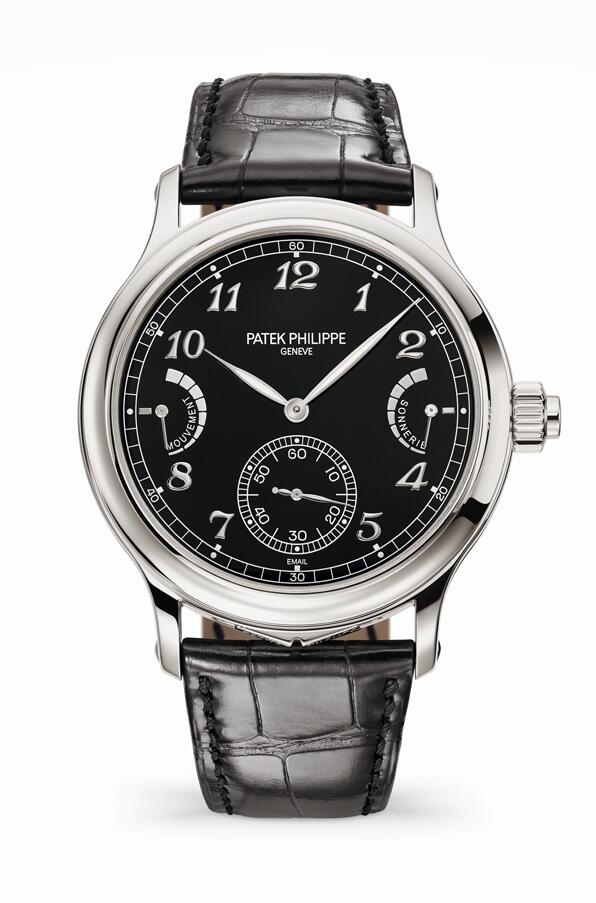Today I present to you the first Patek Philippe wristwatch with a large strike: the Manufacture introduces in its collection the most prestigious and sophisticated of the acoustic functions, the great strike, which marks the hours and quarters as it passes. This great complication of extreme rarity is also combined with a small striking mechanism (which does not repeat the hour at the quarters), a minute repeater (which plays on request) and the patented small jumping seconds. The Grande Sonnerie Ref. 6301P houses a new movement of 703 components in its platinum case, under the black “Grand Feu” enamel dial. The acoustic indication of time is intrinsically linked to the origins of mechanical watchmaking. In the 14th century, most of the monumental clocks that European cities began to equip themselves with had no dials or hands and indicated the passing of time by means of an alarm as it passed. In the fifteenth century, the first portable spring-loaded watches were also equipped, in most cases, with passing ringing mechanisms. The same happens in the 16th century for the first pocket watches. Patek Philippe immediately integrated striking watches into its production: in September 1839, just four months after its foundation, the manufacture included the first example of this type, a repeating pocket watch, in its manufacturing records. In 1850, the same manufacturing archives mention the first pocket high quality replica watches uk with large ring tones. However, it is necessary to wait until the beginning of the twentieth century to see Patek Philippe definitively establish itself for its unparalleled mastery of the great ringtone. The famous pocket watch “Duc de Regla”, sold in 1910 to the Mexican aristocrat of the same name and now exhibited at the Patek Philippe Museum in Geneva, houses a large strike and a minute repeater with Westminster chime on five stamps which reproduces the Big Ben clock melody. The famous “Graves” pocket watch, delivered to the New York banker and collector Henry Graves Junior in 1933, remained the most complicated portable watch in the world until 1989, with a large / small alarm and a minute repeater among its 24 complications. with Westminster music box, completed by an alarm clock, all on five stamps. In 1989, Patek Philippe celebrated its 150th anniversary by presenting the Caliber 89, which will remain the world’s most complicated portable watch for over a quarter of a century. Among its 33 complications, this watchmaking masterpiece integrates a large / small strike and a minute repeater on four timbres. Thus celebrating the great return of mechanical watchmaking, the manufacture is once again dedicated to repeating wristwatches by presenting its first wholly designed and manufactured in-house minute repeater movement, the R 27 caliber. 1989 is a key date marking the rebirth of fake Patek Philippe striking watches. The double-sided pocket watch Star Caliber 2000 (21 complications), created to celebrate the new millennium, contains, for the first time in a case of this size, a Westminster music box on five stamps that faithfully and integrally reproduces the Original London Parliament clock melody. The 2001 Sky Moon Tourbillon wristwatch, the first double-sided wristwatch by Patek Philippe, offers among its 12 complications, alongside the moving celestial map, a minute repeater with “cathedral” stamps. In 2014, on the occasion of its 175th anniversary, Patek Philippe wrote a new important chapter in the field of acoustic complications and presented the Grandmaster Chime Ref. 5175 double-sided wristwatch.Produced in seven pieces, this “grand master of the ringtone” brings together a total of twenty complications, including a large and a small alarm, a minute repeater, an instant perpetual calendar with a four-digit year indication and two patented world premieres: the alarm of the preset time and the repetition of the date that rings on the calendar day at will. This first Patek Philippe wristwatch with large chime – the most complicated wristwatch of the manufacture – joins the current collection in 2016 with the Ref. 6300. In the wake of these achievements, Patek Philippe has introduced into its current collection the Grande Sonnerie Ref. 6301P. To give its own interpretation of the great strike, Patek Philippe has developed a new hand-wound movement derived from the caliber 300 inserted in the Grandmaster Chime. This 703-component caliber GS 36-750 PS IRM stands out for its decidedly compact dimensions considering the complexity of the mechanics (37 mm in diameter, 7.5 mm thick). One of the main difficulties that manufacturers of large ringtones traditionally have to face lies in energy control. Unlike the minute repeater, where generally the chime mechanism is reset each time the user activates the trigger or the trigger button, the large chime must have at all times an amount of energy sufficient to beat the number of shots you want, always producing a sound of equal quality. To meet this challenge, Patek Philippe has equipped the GS 36-750 PS IRM caliber with two pairs of barrels mounted in series, one for the movement and the other for the striking mechanism. This configuration guarantees a power reserve of 72 hours for the movement and 24 hours for the alarm. The movement’s three days of power reserve correspond to what is expected of a modern watch, made to be worn every day, in line with Patek Philippe’s creative philosophy that places the user at the center. The 24-hour power reserve for the alarm allows the watch to strike the hours and quarters as it passes for a whole day, ensuring optimal sound intensity. The user loads the two pairs of barrels through the crown into the position against the case, turning it clockwise for movement and counterclockwise for the striking mechanism. The four springs are equipped with sliding clamps to avoid any overvoltage. For the striking mechanism, Patek Philippe has chosen three classic timbres: grave, medium, acute. This technical option requires more energy than dual tone systems. In addition, it further complicates the watchmaker’s work during the meticulous tuning phase of each timbre, up to obtaining the famous “Patek Philippe sound” sought after by connoisseurs. The difficulty lies in the fact that, despite the extremely limited space, the three stamps attached to the movement must not touch each other nor must they come into contact with other elements of the movement or case. The mechanism involves three hammers of equal size and mass which guarantee a uniform beat for the three notes. For the case, Patek Philippe has chosen platinum and not gold, well aware that with this material it is more difficult to obtain a perfect sound, and this further challenge required the mobilization of all the savoir-faire that the manufacture transmits from generation to generation. in generation. The hours are marked by low blows and the quarters by a succession of three high-low-medium blows, a melody that resounds once in the first quarter (15 minutes), twice in the second quarter (30 minutes) and three times in the third quarter. (45 minutes). At each quarter, the big chime automatically marks the number of hours followed by the number of quarters. In this way, a total of 1,056 shots resound every 24 hours, thanks to the energy stored in the double barrel of the ringer. The user can also opt for the “small ringtone” mode. In this case, the clock strikes the hours at full hours, then only the quarters at each quarter, without repeating the hours.

